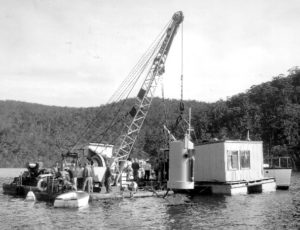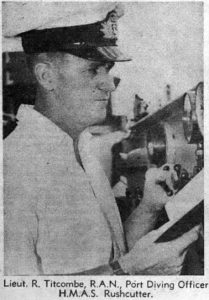The Clearance Diving Branch of the Royal Australian Navy was formed in 1951 with the primary role of “location, identification and disposal of mines underwater”. Its secondary roles included “underwater maintenance, training of the Fleet in ship defence against saboteurs, beach reconnaissance and minor salvage”. The maintenance role was put to the test in 1961. The following extract from Ross Blue’s monograph United and Undaunted published by the Society in 1976 describes one of the most difficult maintenance tasks undertake by RAN Clearance Divers.

“Early in 1961, the Snowy Mountains Authority had a major problem in the Lake Eucumbene Dam. A leak had developed in a temporary sealing device at the entrance to the Lake diversion tunnel and the only practical method of checking the trouble was by diver inspection. The job was at a depth of 260 feet and although the RAN CDs had only worked regularly to depths around 100 feet, these were the only divers capable of the attempt. A composite team was formed in Rushcutter under the direction of Leut Titcombe and, after the procurement of Special-to-task equipment and a short deep diving workup, the job was tackled. The work was protracted and done in freezing conditions. To remove twenty 3½ ton racks from the side of the 230 foot intake tower and twenty eight 5 ton ‘stop logs’ sealing the tunnel inside the tower was a major evolution for men working in a completely new depth environment with new equipment. Their perseverance in the face of nitrogen narcosis and decompression stoppages (which lasted up to 1½ hours for a 15 minute task time) was nothing short of Spartan. The submersible decompression chamber was utilised to improve conditions during decompression and pure oxygen was eventually employed to shorten stoppage times but the overall picture was never pleasant. As the job dragged on winter set in, lowering the water temperature still further and raising the level of the Lake to increase the decompression problem, but the leak was defeated and the tower’s fittings replaced without a major injury to any team member.’
The Canberra Times of Saturday 4 March 1961
This is the most ambitious deep-diving assignment attempted in Australia, and will be performed in water only nine degrees above freezing point. Lack of visibility will require lighting, and special diving suits to withstand temperature and pressure will be used.

Yesterday the Minister for the Navy, Senator Gorton, said the job would be done in the greatest depth ever attempted in the Southern Hemisphere.
The job was expected to take three weeks, and would involve a particular problem
Normally a slow ascent would be necessary for depths, but this policy had to be ruled out because the divers would have to spend too long in the cold water.
The problem would be overcome by using the navy’s submersible decompression chamber on the spot as an underwater “elevator” to bring the divers to the surface before decompressing them.
Navy Doctor Studies Underwater Medicine
The following story was released by Navy Public Relations on 21 December 1961.
A Naval doctor who will establish an underwater medical unit for the Royal Australian Navy has left for a special training course in the United Kingdom. The Minister for the Navy, Senator Gorton,’ said today that Surgeon Lieutenant-Commander R. Gray had been selected to head the RANs Underwater Medical School. This unit will make a concentrated investigation into the physical problems of underwater work, and will constantly strive to increase the medical knowledge in this field.
In the United Kingdom, Surgeon Lieutenant-Commander Gray will study the latest developments in underwater medicine, and will attend the Royal Navy’s physiological laboratory. He is the first Australian officer to undertake this special training. Surgeon Lieutenant-Commander Gray, who was formerly a Sydney Anaesthetist, joined the Royal Australian Navy’s diving team at HMAS Rushcutter in Sydney earlier this year. He personally underwent the rigorous naval diving course to obtain firsthand knowledge of practical aspects of diving. He also obtained valuable information while serving as medical advisor to the Navy diving team that made record descents at Lake Eucumbene this year. He has compiled clinical records of the ailments of divers and the pattern of physical behaviour under stress conditions. The Royal Australian Navy has helped pioneer Naval diving, and today Australia is one of the leading nations in clearance diving techniques.
Lieutenant Commander Robert Titcombe RAN

An early member of the RAN Clearance Diving Branch Ronald Titcombe had a distinguished twenty career in the Royal Australian Navy. The following extract from Bravo Zulu Volume 1: Honours and Awards to Australian Naval People Volume 1, 1900-1974 by Dr Ian Pfennigwerth published in 2016 describes his career.
‘Born in Paddington NSW, Ronald Titcombe joined as a Midshipman RANRS in 1948. In 1954 he was promoted Lieutenant in the permanent force and in 1955 completed a clearance diving course and joined the East Australia Mobile Clearance Diving Team. Between 1956 and 1959 he was posted to the UK on courses and exchange with the RN. In 1960 he was appointed an MBE for his service with the RN when he showed exceptional skill and exposed himself to risks in recovering a helicopter which ditched near Portland UK’. To find the cause of the crash the aircraft need to be recovered. It was in water over 50 metres deep, so the divers needed to recompress on surfacing—the first use of clearance divers on this kind of task—and the job was made more difficult by the strong tides (which ruled out the use of standard divers) and the poor weather in which the recovery had to be conducted. His citation concluded that ‘The success of the operation was largely due to the intelligent appreciation of the situation, the leadership and the fine personal efforts of Lieutenant Titcombe.
On his return to Australia in 1960 he became Officer-in-Charge of the Diving School and his experience of recompression was valuable in the Lake Eucumbene operation in 1961 where he led the RAN diving team. He was promoted Lieutenant Commander in 1962 and posted on exchange to Malaysia. After a tour as Executive Officer of Vampire, he joined Navy Office where he did much to develop the Clearance Diving branch, particularly in advocating for the formation of Clearance Diving Team Three for service in Vietnam. He resigned from the RAN in 1968 but maintained his interest and involvement in commercial diving and wrote a Handbook for Professional Divers, published in 1973.’




